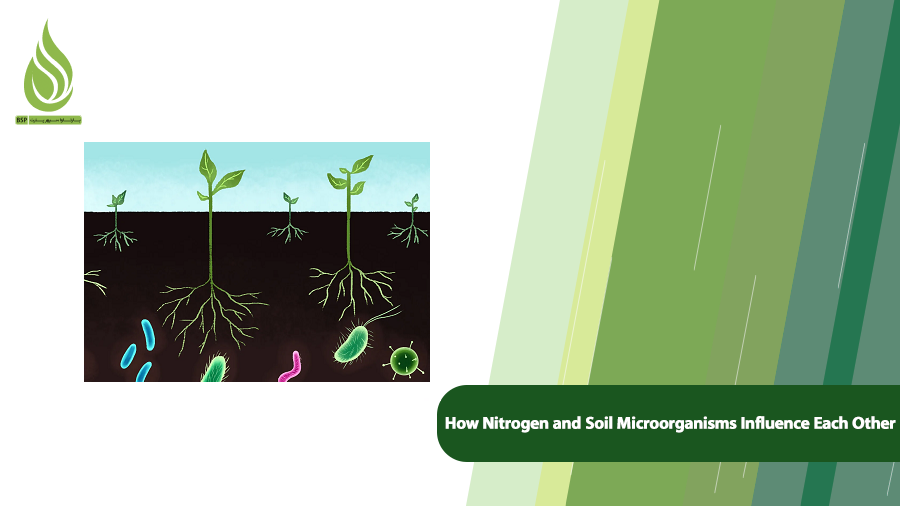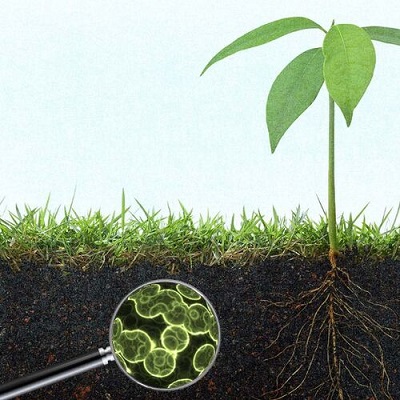
How Nitrogen and Soil Microorganisms Influence Each Other
Nitrogen and the microorganisms living in soil each play essential roles in plant growth. What’s fascinating is how they positively impact one another. Nitrogen enhances the activity of these microorganisms, while the soil microbiome, including bacteria, fungi, and other microbes, contributes to nitrogen fixation and the overall nitrogen cycle. In this article, we’ll explore how nitrogen affects microbial activity and explain the role of microorganisms in the nitrogen cycle. Join us as we dive deeper into this symbiotic relationship.
The Importance of Nitrogen in Soil
Nitrogen is one of the most critical macronutrients for plants, making up about 2 to 5 percent of a plant’s dry weight. Its key functions include:
- Building Proteins and Amino Acids: Without nitrogen, plants can’t properly grow or divide cells, as it’s a fundamental building block for these essential compounds.
- Producing Chlorophyll: Nitrogen is directly involved in photosynthesis, and a deficiency can lead to yellowing of leaves, known as chlorosis.
- Boosting Vegetative Growth: It promotes lush greenery, larger and healthier leaves, and overall vigorous plant development.
- Influencing Microorganisms: Adequate nitrogen provides energy and optimal conditions for the growth and reproduction of beneficial soil microbes.
- Enhancing Crop Yields: Plants with sufficient nitrogen produce higher yields and better-quality fruits or grains.
A lack of nitrogen in the soil results in stunted plant growth, reduced photosynthesis, lower productivity, and smaller fruits. According to agricultural experts, nitrogen deficiency can reduce crop yields by up to 50% in some cases, highlighting its indispensable role in farming.

To expand on this, nitrogen exists in soil in various forms, such as organic nitrogen from decaying matter, ammonium from fertilizers, and nitrate, which is readily absorbed by plants. Organic nitrogen, for instance, has been shown to influence soil microbial communities by decreasing the complexity of bacteria-fungi interactions, which can affect overall soil health. This underscores the need for balanced nitrogen management to support both plants and the underlying microbial ecosystem.
The Importance of Microorganisms in Soil
Soil microorganisms encompass a diverse group including bacteria, fungi, tiny algae, and more, all naturally inhabiting the soil. Each type contributes uniquely to soil processes. Their key roles are:
- Decomposing Organic Matter: Microbes break down plant and animal residues into minerals that plants can absorb. Different microbes specialize in decomposing specific organic materials, ensuring efficient nutrient recycling.
- Nitrogen Fixation: Certain bacteria convert atmospheric nitrogen into forms usable by plants, such as ammonia.
- Increasing Soil Fertility: By releasing nutrients and improving soil structure, microbes create better conditions for plant growth.
- Combating Pests: Beneficial microbes protect plant roots from harmful fungi and pathogens.
- Improving Aeration and Water Retention: Mycorrhizal fungi form networks that enhance water and mineral absorption.
A decline in microbial populations can disrupt the natural nutrient cycles in soil, leading to reduced fertility over time. Research indicates that these microbes are vital for soil development through processes like organic matter decomposition and the dissolution of elements such as nitrogen, phosphorus, and potassium. For example, protists, a type of microbe, are particularly sensitive to nitrogen changes and can influence bacterial and fungal communities more strongly than other factors.

Beneficial plant-microbe interactions also ward off pathogens, reduce plant stress, and promote nutrient cycling. When farmers nurture these microbes, they can improve soil aggregation and water-holding capacity, ultimately leading to healthier crops. In diverse plant systems, these interactions strengthen positive microbial associations in the rhizosphere—the soil zone around roots—enhancing overall ecosystem resilience.
How Nitrogen Influences Soil Microorganisms
Nitrogen is a key element in building proteins, enzymes, and chlorophyll in plants. Meanwhile, soil microorganisms drive the nitrogen cycle. Without both, the plant nutrient cycle remains incomplete, and soil fertility declines.
The Role of Nitrogen in Nourishing Soil Microorganisms
Soil microbes, including bacteria, fungi, and actinomycetes, require various nutrients for survival and biological processes. Nitrogen stands out as a fundamental element that determines their growth and activity. In soil, nitrogen appears in forms like nitrate, ammonia, and molecular nitrogen, each affecting microbial behavior differently.
The importance of nitrogen for microbes includes:
- Forming Proteins and Enzymes: As a core component of amino acids, nitrogen is essential for protein synthesis. Proteins, especially enzymes, are crucial for microbes to decompose organic matter and carry out metabolic reactions.
- Building Nucleic Acids (DNA and RNA): Genetic molecules can’t form without nitrogen, making it vital for cell division, reproduction, and maintaining microbial populations.
- Providing Metabolic Energy: Some microbial groups use nitrogen compounds like ammonium or nitrate as energy sources, particularly in nitrifying bacteria.
- Regulating Carbon-to-Nitrogen Ratio (C/N Ratio): The efficiency of organic matter decomposition depends on this ratio. Sufficient nitrogen accelerates microbial activity and mineralizes organic materials more effectively.
The presence of adequate nitrogen in soil leads to:
- Increased Population and Diversity of Beneficial Microorganisms: It boosts microbial diversity and metabolic activities.
- Accelerated Biological Cycles: Faster nutrient turnover benefits the entire ecosystem.
- Enhanced Soil Fertility: Through the release of plant-available nutrients.
- Long-Term Ecosystem Stability: Supporting a balanced soil environment.
Overall, nitrogen isn’t just vital for plants; it’s a key factor in feeding and dynamizing soil microbes. Studies show that nitrogen inputs can alter soil microbial beta-diversity while leaving alpha-diversity unchanged, influencing nitrogen cycling and nutrient contents. Additionally, ammonia leakage among microbes can serve as a nitrogen-sharing mechanism, fostering community cooperation.

Nitrogen can also increase microbial diversity, meaning a wider variety of species that improve soil quality and plant performance. For instance, in agricultural soils, tipping the balance in plant-microbe competition for nitrogen can enhance uptake through microbial activities like fixation and transport. Plant-microbe interactions converge on nitrogen absorption, with availability limiting growth and activity.
How Microorganisms Complete the Nitrogen Cycle
Nitrogen is essential for all living organisms’ growth and survival. Although 78% of the atmosphere is nitrogen, most organisms can’t access it directly. The nitrogen cycle exists to convert atmospheric nitrogen into usable forms for plants and others.
Soil microorganisms play a pivotal role in this transformation through biochemical reactions.
The nitrogen cycle has several key stages, each handled by specific bacteria and microbes:
- Nitrogen Fixation: Free-living soil bacteria or symbiotic ones in plant roots convert atmospheric nitrogen to ammonia. Examples include Rhizobium in legumes.
- Nitrification: Nitrifying bacteria turn ammonia into nitrate, which plants can use. This involves two steps: ammonia to nitrite by Nitrosomonas, then nitrite to nitrate by Nitrobacter.
- Nitrogen Assimilation: Plants absorb nitrate via roots, incorporating it into proteins and chlorophyll.
- Ammonification: Decomposing bacteria convert organic nitrogen from wastes back to ammonia, recycling it.
- Denitrification: Denitrifying bacteria convert nitrate to gaseous nitrogen, returning it to the atmosphere and preventing excess buildup.
The cycle is biologically driven, with microbes transforming nitrogen forms. Bacteria fix N2 into ammonia, which animals acquire through plants. Decomposers add nitrogen back to soil, and nitrification converts ammonia to nitrites and nitrates.
Human Impacts on the Nitrogen Cycle and Soil Health
The nitrogen cycle is a natural, complex process essential for ecosystem stability and plant growth. However, human activities over recent decades have disrupted it. Excessive chemical fertilizer use, land conversion, habitat destruction, and industrial emissions alter nitrogen flows.
These interventions reduce microbial diversity and imbalance processes like fixation, nitrification, and denitrification. Consequences include nitrogen accumulation in some areas and shortages in others, leading to soil fertility loss, water pollution, and increased atmospheric gases.
Global studies show nitrogen deposition reduces microbial biomass, bacterial and fungal biomass, and respiration. Long-term excess nitrogen makes microbial communities more sensitive to changes. It can harm beneficial microbes, impact water use, and degrade soil quality.
The Positive Symbiosis Between Nitrogen and Microorganisms for Plants
The positive interaction between nitrogen and microbes improves soil quality and boosts agricultural output. This symbiosis sustains the soil nutrient cycle: sufficient nitrogen activates microbes, which convert it into plant-available forms. The result is more fertile soil, better plant growth, and higher yields.
Nitrogen and microbes have a mutual, positive relationship. Nitrogen stimulates microbial metabolism, aiding organic decomposition and energy production. Adequate nitrogen increases microbial diversity, while microbes enable root nitrogen uptake and soil denitrification. Proper soil management and fertilizer use can strengthen this cycle, enhancing farm fertility.
Tripartite interactions in legumes with mycorrhizal fungi and rhizobia synergistically increase growth. Microbes fix nitrogen, turning it into chlorophyll components for photosynthesis.
The Downsides of Excessive Nitrogen Fertilizer Use
Using nitrogen-based chemical fertilizers is common in agriculture to boost plant growth. However, overuse harms microbial populations and soil quality. It reduces nitrogen-fixing bacteria, depletes organic matter, and increases soil acidity. Higher acidity kills beneficial microbes and lowers fixation efficiency. Nitrogen should match soil needs; test soil before planting. To mitigate issues like pH changes, use ammonium sulfate instead of urea.
Excessive nitrogen favors certain microbes, shifting communities and causing degradation like salinization. It decreases bacterial abundance over time, favoring fungi. Long-term overuse inhibits early crop growth by impacting diazotrophs.
Ways to Enhance Nitrogen’s Impact on Microorganisms
To optimize this relationship:
- Balanced Nitrogen Fertilizer Use: Apply only what’s needed.
- Slow-Release and Organic Fertilizers: Reduce leaching and support microbes.
- Water Management: Prevent nitrate washout.
- Plant Nitrogen-Fixers: Like clover or alfalfa in rotations.
- Soil Testing: Determine exact nitrogen requirements.
- Crop Rotation: Maintain soil health.
Additional strategies include harnessing microbes for better nutrient uptake via genetic modifications or biofertilizers. Optimizing soil properties and fertilizer methods improves efficiency. Mycorrhizal fungi and nitrogen-fixers enhance availability. Nitrogen starvation can stimulate beneficial rhizosphere communities. Supporting microbes increases aggregation and stress reduction.
In conclusion, understanding and managing the interplay between nitrogen and soil microorganisms is crucial for sustainable agriculture. By adopting these practices, farmers can foster a healthier soil ecosystem, leading to improved productivity and environmental benefits. This expanded view, drawing from scientific insights, emphasizes the need for balanced approaches in modern farming.
